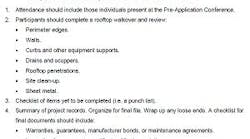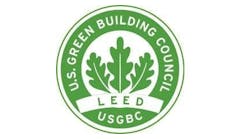Building owners are generally aware that a premature roof failure is a major concern. Attempts to focus on the reasons for failures are many, and documents have been created to minimize the financial responsibility of such failures.
Looking back to bonds and guarantees, it was reported that in 1905, the old Barrett Company originated the specification roof, with its prescription for number of plies, quantity of bitumen, and best applications.
Barrett found that it was too difficult to control the workmanship of roofing contractors all over the country, so it introduced the roofing bond in 1916. This original roofing bond guaranteed the built-up membrane for 10 years against leaks attributable to material failure or faulty application, according to 2006’s Manual of Low-Slope Roof Systems. The mechanics of the manufacturer’s bond were as follows: the roofing materials manufacturer issued the bond, which was backed by a surety company pledged to assume the manufacturer’s potential liability for a failed roof. The bond was designed to assure the owner that:
1) The manufacturer’s materials were used.
2) The membrane and base flashing (if included in a supplementary flashing bond) were installed by a manufacturer-approved roofer.
3) The manufacturer’s representative had inspected the installation during application and after completion.
Since then, two alternatives to the old roofer’s bond have emerged:
Manufacturer’s warranty: This document is backed by the company itself instead of a surety company. Like a manufacturer’s bond, a warranty establishes a direct contractual relationship between owner and manufacturer, irrespective of the involvement of the architect, general contractor, and roofer in its procurement.
Roofer’s guarantee: A one- or two-year guarantee may supplement, or, in some cases, may replace a long-term manufacturer’s guarantee. The typical roofer’s guarantee requires the roofer to repair leaks resulting “solely from faults or defects in workmanship applied by or through the roofer.” The logic here is that most leaks might occur during the first two years of weather exposure.
Richard (Dick) L. Fricklas, received a Lifetime Achievement Award and fellowship from RCI in 2014 in recognition of his contributions to educating three generations of roofing professionals. A researcher, author, journalist, and educator, Fricklas retired as technical director emeritus of the Roofing Industry Educational Institute in 1996. He is co-author of The Manual of Low Slope Roofing Systems (now in its fourth edition) and taught roofing seminars at the University of Wisconsin, in addition to helping develop RCI curricula. His honors include the Outstanding Educator Award from RCI, William C. Cullen Award and Walter C. Voss Award from ASTM, the J. A. Piper Award from NRCA, and the James Q. McCawley Award from the MRCA. Dick holds honorary memberships in both ASTM and RCI Inc.
Guarantees and Performance
The issue of long-term performance was raised in Roofing Contractor magazine’s February 2015 issue. You may recall that the Superdome in New Orleans originally had a spray-in-place (SPF) polyurethane foam roof, surfaced with a reflective roof coating. SPF has excellent thermal resistance, especially when this structure is located in a climate as humid as New Orleans and is intended to be air-conditioned. The Superdome opened in 1975, and was constructed with a polyurethane foam roof. In the late 1970s a massive hailstorm with golf-ball-sized hail caused small dents in the foam that resulted in circles of exposed foam. The damaged roof did not leak. The roof continued to waterproof and insulate.
In 2003 the polyurethane foam roof was torn off and replaced with a state-of-the-art EPDM rubber roof system. The manufacturer guaranteed the new roof to withstand winds up to 130 mph. When Hurricane Katrina struck in 2005, 100 mph winds blew off most of the EPDM roof. The membrane failed after just two years at wind speeds substantially less than promised.
Many metal roof deck panels were removed and replaced, followed by a new application of SPF over the entire 13 acres of roof surface. Technical information is available on the new water-based Kynar coatings, along with the traditional disclaimers.
Other experiences with warranties and guarantees should be checked out. Accelerated weathering devices may not represent the real world. When polyisobutylene was introduced for roofing purposes back in the 1960s, it was found to be remarkable for its durability in the Weatherometer, but unfortunately not on real roofs.
Another sad result was experienced in an attempt to improve profitability during the oil embargo of the early 1970s. Instead of installing the conventional built-up roofing with four layers of roofing felt, 2-ply roof systems were introduced. The conventional wisdom was that “one plus one equals four,” so bonds were offered as 20-year roofs even though they were a miserable flop. Roof consultants commented that not only do two-ply roofs not equal four, but they don’t even meet two!
Alternatives to Long-Term Guarantees
Near the end of the roof bond era, some manufacturers introduced a “five plus five guarantee.” Under this plan, the roof would be inspected by the guarantor upon completion, at the end of two years of service, and again after five years. At the owner’s option and expense, the roof could be patched if needed, and upon completion, another five-year guarantee could be issued.
The advantages of this short-term program are several:
- The specifier and owner are not deluded into thinking roofs last 20 years without inspection and maintenance.
- The manufacturer provides at least some inspection services, considering that most building owners are likely to forget about the roof until it leaks.
- Most roofs require some service by five years, even if it is no more than removing debris from drains or replacing displaced ballast.
The promotion of longer-term warranties can actually be counter-productive. They encourage the same mentality as the 20-year bond – that roofs require neither inspection nor maintenance.
They also imply longevity, when in fact roofs rarely have the opportunity to simply wear out. Punctures or leaks to due to abuse are just as likely to occur in three years as in 20.
Alice in Warranty Land
Why warranties shouldn’t be used as sales gimmicks.
Is Your Roof Warranty Really Protecting You?
3 keys to avoiding pitfalls.
Time for Roof Replacement
Identify the right resources for every roof.


